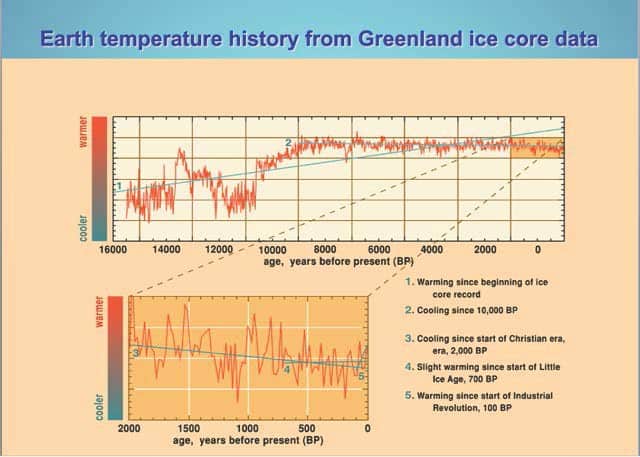- The Paris Climate Agreement was a cruel hoax on the 99%
- The Paris Climate Agreement: What are the consequences?
- Risks from poverty are far greater than from climate change
- Temperature variations over the last 10,000 years
- Global temperature and volcanic activity
- Inexorable natural climate change must not be ignored
- Negotiating from ignorance
- Sources of greenhouse gases in the atmosphere
- Sea level
- Sea-level changes over time
- Glaciation
- Carbon dioxide levels and temperature
- Temperature changes over 541 million years
- Duration of climate effects
- Temperature variations from Greenland ice cores
The Paris Climate “Agreement” was a cruel hoax on the 99%
Victor John Yannacone jr , Attorney and Advocate and Lee C. Gerhard, Kansas State Geologist (Retired), Senior Scientist Emeritus, University of Kansas
Carbon dioxide from human industrial activity makes no significant contribution to global climate change. Insisting that it does and then basing economically disastrous policies on that assumption is the height of folly.
Nevertheless, politicians, demagogues and luddite evangelists have joined together to condemn the poor to continuing poverty because of their theological conviction that carbon dioxide from human economic activities is the cause of global climate change.
They justify their failure to ameliorate injustice and offer equal opportunity to the peoples of the world with the false assumption that carbon dioxide from human activities is the cause of global climate change. Their “science advisors” know, or with the reasonable exercise of the scientific method and care for the integrity of Science should know, that the assumption that carbon dioxide from human industrial activities is a cause of global climate change is false.
What happens if The Paris Climate Agreement is implemented?
The Paris Climate Agreement will trap the poor in poverty for generations. It will be a disaster for the poor around the world. It will slow their access to the abundant, affordable, reliable energy indispensable to rising from and staying out of poverty. It will divert trillions of dollars from meeting the real challenges of hunger, malnutrition, and disease. It will not address, much less redress, the lack of opportunity and disparity of income that continues to divide the ever richer “1%” from the rest of the working people on Earth.
Risks from poverty are far greater than from climate change.
Full compliance with the Paris agreement would cost hundreds of billions of dollars per year now and rise to $1–2 trillion per year from 2030 onward while reducing carbon dioxide emissions by only 1% of the amount the Intergovernmental Panel on Climate Change says is needed to limit global warming to 2˚C (3.6˚F) over pre-industrial levels.
Global temperature will continue to fall and rise on regular cycles as it has throughout earth’s history, regardless of the amount of carbon dioxide produced by human beings.
Temperature variations over the last 10,000 years
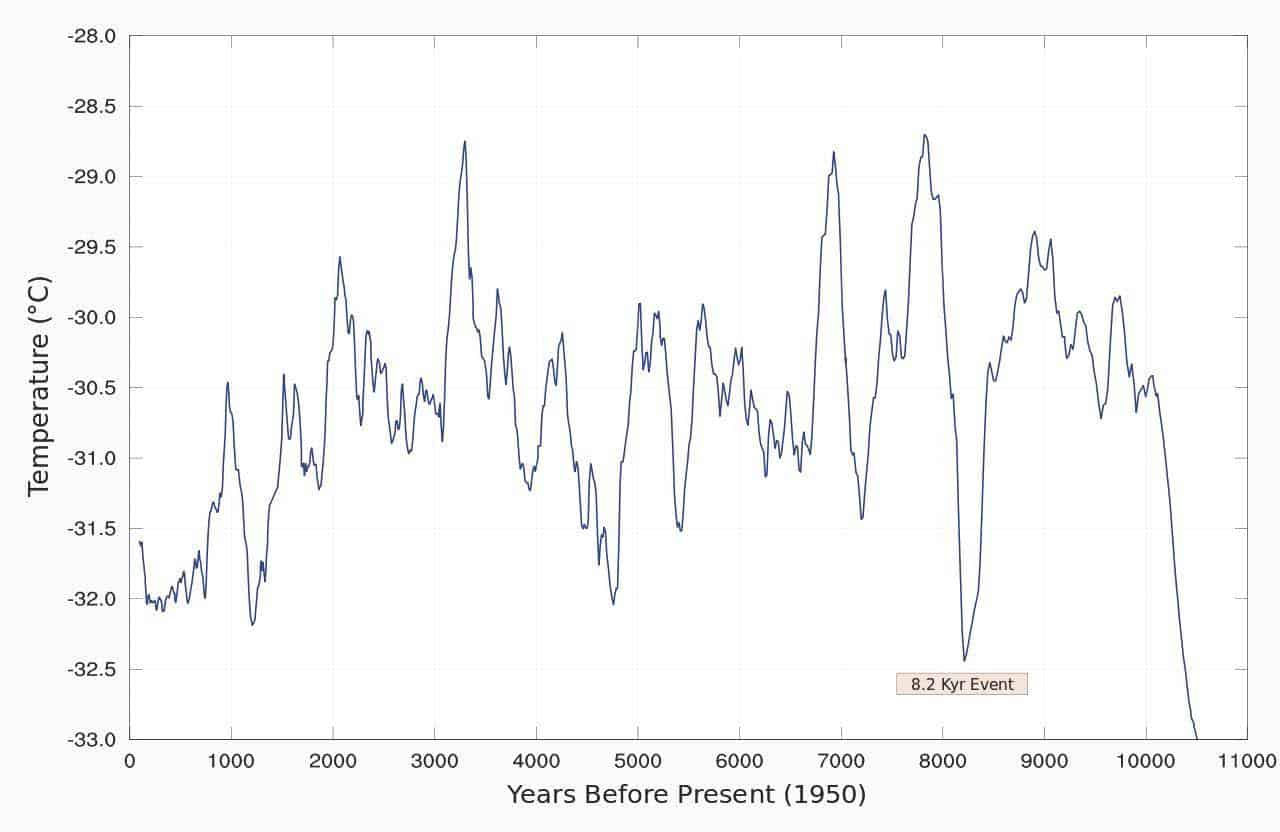
Global temperature and volcanic activity
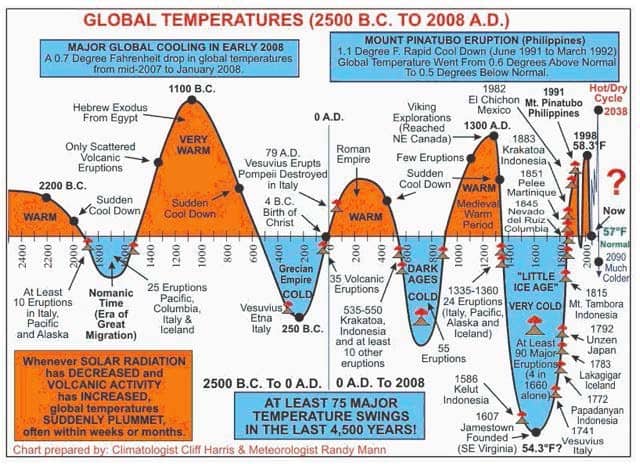
Global temperatures and volcanic activity (2500 bce to 2008 AD
Inexorable natural climate change must not be ignored
The political leaders of the member states of the United Nations including the United States have ignored natural climate change documented over millennia and now condemn the world’s poor to permanent poverty.
They have ignored the inexorable biogeochemical forces of natural processes for millennia and, as a result, many improvidently situated concentrations of population are now at risk.
Carbon dioxide had nothing to do with the destruction from Hurricane Katrina. The inadequate poorly maintained levees failed and the death and destruction resulted from the lack of rational land use planning as the City of New Orleans grew in a bowl shaped depression below sea level adjacent to the Gulf of Mexico in a region regularly subject to hurricanes and their associated storm surges. Relying on levees rather than enhancing the natural barrier beaches and islands which protected the City for generations made the disaster inevitable.
Negotiating from ignorance
All of the “negotiations” at the 2015 Paris climate “summit” were based on the false premise that anthropogenic greenhouse gases, particularly carbon dioxide, are the cause of global climate change.
While affirming that climate change is one of the most important issues in the world and always will be, the poorly informed and badly advised political leaders did nothing to mitigate the effects of naturally occurring climate change other than make empty promises of financial aid to those peoples who will suffer from the predictable effects of climate change which will occur eventually regardless of the amount of carbon dioxide may be produced from human activity.
Carbon dioxide from human activities amounts to less than three-tenths of one percent (.28%) of the greenhouse effect. It has almost no effect on global temperature and none whatsoever on the severity of storms and floods.
Sources of greenhouse gases in the atmosphere
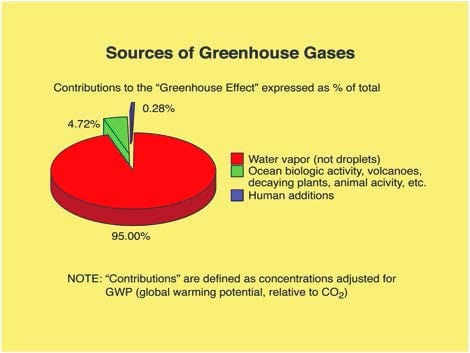
Atmospheric carbon dioxide levels naturally rise as a consequence of warming, owing to both increased greening of the Earth and degassing from the oceans, and, of course, volcanic activity. Human activity may have added to the concentration in absolute terms, but any human contribution is insignificant and will continue to be inconsequential.
Sea level
Earth dynamic processes are not in equilibrium. Sea level will continue to rise slowly until the next glacial episode reverses the rise without regard to atmospheric levels of carbon dioxide. Sea level has risen over eighty feet since the end of the last glacial advance and will continue to rise until there is sufficient warm Atlantic water spilling over the Greenland-Iceland sill to create an open Arctic Ocean.
Rising sea level is not an artifact of human industry. Industrial progress will not raise sea levels but will lower poverty levels.
Sea-level changes over time
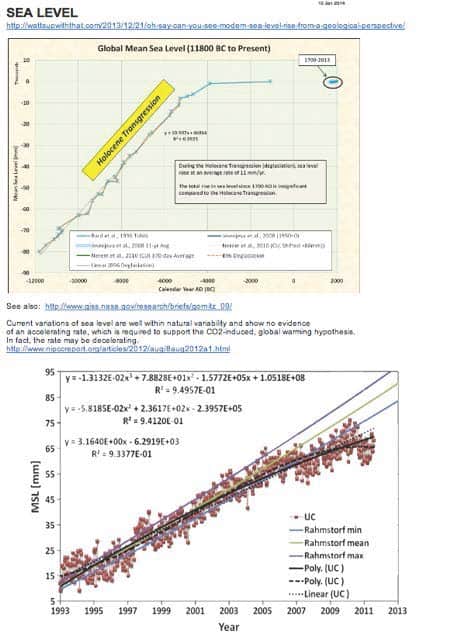
Glaciation
Continental glaciers require vast amounts of snow to create mile-thick wedges of ice. The Arctic Ocean is covered by ice in the winter and much of the summer preventing evaporation, resulting in more ice melt from existing glaciers than addition of new snow, thus raising sea level. Ocean warming can also raise sea level as water expands with warming.
When sufficient warm Atlantic water creates a completely ice-free Arctic Ocean, evaporation will eventually exceed ice melt and the next round of glaciation will begin. No amount of human intervention or carbon dioxide will influence this natural cycle.
Carbon dioxide levels and temperature
The data clearly show that in nature, temperature rises first, then CO2 levels. Carbon dioxide does not drive the rise in global temperature, increasing global temperature drives the rise in atmospheric carbon dioxide levels.
Modern measurements of carbon dioxide in the atmosphere show a steady rise from early measurements in the late 19th century to the present. Thermometer data document that temperatures climbed from then to 1934, then descended to about 1970, then started to rise, culminating through the late 1990’s, and has been stable or slightly decreasing since. The lack of any correspondence between temperature and atmospheric CO2 levels falsifies any claim that CO2 drives global temperature.
By carefully selecting the period from 1970 to 1998 during which both the CO2 level and temperature rose, unscrupulous politicians and social engineering zealots claim human industrial activity directly affects Earth’s most short-term dynamic system. Short-term correlation does not establish causation, however.
Climate, and thus weather, is short term, measured in decades, human life spans, and centuries. Seafloor spreading, magnetic pole movement, crustal distortion, all are longer term.
The current geologic eon which began 541 million years ago and continues to the present, the Phanerozoic is characterized by rapid emergence of a number of animal phyla; the evolution of these phyla into diverse forms; the emergence and development of complex plants; the evolution of fish; the emergence of insects and tetrapods; and the development of modern faunas.
During this time tectonic forces caused the continents to move and eventually collect into a single landmass known as Pangaea, which then separated into the present day continental landmasses.
Any discussion of global climate change has to cover this entire eon and we hae to understand where our present generations fits in the overall history of our Earth.
Temperature changes over 541 million years
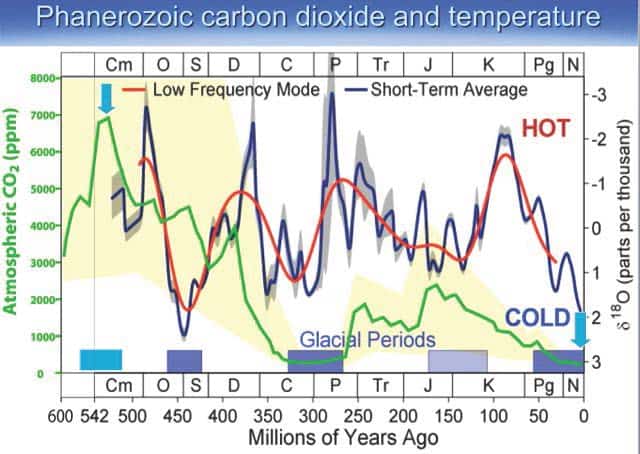
Phanerozoic temperature variations
Duration of climate effects
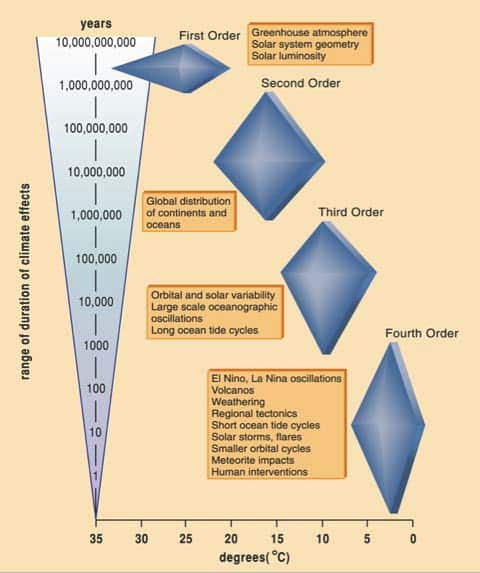
Global temperature will continue to fall and rise on regular cycles as it has throughout earth’s history, with us or without us.
Temperature variations from Greenland ice cores
